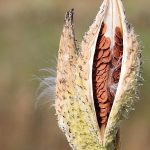 A dry dehiscent fruit composed of two or more united carpels, opening by valves, slits or pores.
A dry dehiscent fruit composed of two or more united carpels, opening by valves, slits or pores.
A dry, dehiscent fruit composed of more than one carpel.
A dry fruit formed from two or more carpels that splits at maturity to release the seeds.
Dry fruit that splits open when ripe to scatter seeds.
Dry, dehiscent (splitting open) fruit in the form of a case containing seeds.
A dry fruit composed of more than one ovary (example: yucca fruit).
Any dehiscent fruit made up of more than one carpel.
Hard or soft soluble containers used for the oral administration of medicine.
An envelope surrounding many types of microorganisms. The capsule is usually composed of polysaccharides, polypeptides, or polysaccharide-protein complexes. These materials are arranged in a compact manner around the cell surface. Capsules are not absolutely essential cellular components.
A dry, several-seeded fruit made up of more than one carpel and splitting open lengthwise at maturity.
A capsule contains finely chopped, ground, or powdered dried plant material sold commercially and often used in clinical trials. Take as instructed.
A small, dissolvable container, usually made of gelatin, that contains a dose of medication for swallowing. Some capsules have special coatings to prevent the release into the stomach of drugs that may be irritating; other capsules are designed to release their contents into the small intestine slowly and steadily so that a drug need not be taken as often.
A dry fruit divided into two or more seed compartments that split longitudinally or, uncommonly, around the circumference.
A dry dehiscent fruit composed of two or more united carpels, opening by valves, slits or pores.
A dry fruit that opens into two or more parts (valves), or by holes or a lid, to release the seeds.
A fruit which when ripe dries and opens to release the seeds, such as the fruits of lilies and petunias.
In botany, a dry fruit that develops from a compound pistil and opens in various ways, allowing the seeds to escape.
A small hollow digestible case filled with a drug that is taken by swallowing.
A fruit developing from 2 or more fused carpels which when ripe dries and splits open to release the seeds. If formed from a single carpel, such a fruit is usually termed a pod or follicle.
Envelope-like structure enclosing an organ or part (e.g.. Bowman’s capsule, which encloses a glomerulus in the kidney).
A form in which certain drugs are prepared. A capsule is a shell made of gelatin that contains the drug in powdered form, liquid, or tiny slow-release particles.
A membrane, sheath, or other structure that encloses a tissue or organ. For example, the kidney, adrenal gland, and lens of the eye are enclosed within capsules. A joint capsule is the fibrous tissue, including the synovial membrane, that surrounds a freely movable joint.
A term used in several senses in medicine. It is applied to a soluble case, usually of gelatine, for enclosing small doses of unpleasant medicine.
A dry fruit with one or more seeds, which splits open when ripe by pores or slits, but not down one side (a follicle) nor down two sides (a pod or siliqua).
A diminutive receptacle, imbued with the property of aqueous solubility, purposed for the oral bestowal of a precise amount of therapeutic substance. Its abbreviated nomenclature being cap.
A capsule is an anatomical structure that surrounds and encloses an organ or a specific part of the body. For instance, the liver, kidneys, joints, and lenses of the eyes are all encompassed within capsules.
The term “capsule” is also employed to describe a dissolvable, elongated casing typically composed of gelatin that houses a medication intended for oral ingestion. In certain cases, the shell of such capsules serves to shield potentially irritating drugs from premature release within the stomach, while in other instances, it facilitates controlled and gradual drug release, allowing for less frequent administration.
A dissolvable gelatin casing used to enclose medications.
Dry fruits with numerous seeds that either split open or form pores to release their seeds.
